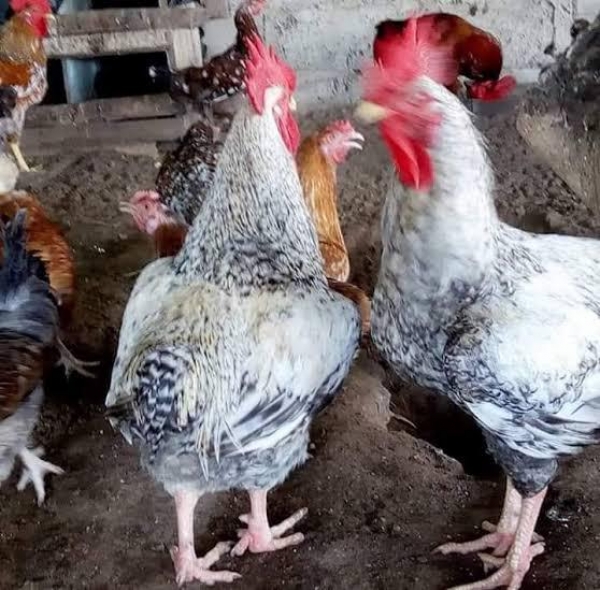Kuroiler chicken and Noiler chicken breed are hybrid breeds of chicken developed to meet consumers demands and also increase in productivity with relatively low input, hence, making the enterprise more lucrative. These two breeds of chicken are good converter of feed; they are dual purpose breed with relatively good yield compare to other breeds of chicken, they are hardy and more resistant to poultry diseases.
These virtues have made Kuroiler chicken and Noiler chicken desirable.
Kuroiler chicken and Noiler chicken are different breeds, some farmers still think they are the same, probably as a result of their plumage or appearance. They are different breeds; the differences between the two breeds shall be discuss in this article with their economic benefits.
Characteristics of Noiler Chicken
The Noiler chicken is a dual-purpose breed of chicken developed in Nigeria by Amo Farm Sieberer Hatchery. Noiler is a hybrid of broiler and cockerel, thus, share desired traits of both broiler and cockerel.
1. Appearance
Unlike broiler chickens, Noiler chickens come in varying colors: black, white, yellowish, brown and grey patches.
2. Growth rate
Noiler chicken is a fast-growing chicken; they consume more than other breeds but are good converter. they mature at 4 months with weight varying from 3-4kg. They are good converter of feed.
Noiler chickens can be harvested at four months and the farmer can get over 3kg of meat compared to cockerel which takes about six months to attain 2kg. Aside from their fast-growth rate, they are good foragers and can thrive well on forage and kitchen waste.
3. Noiler meat
Noilers meat possesses white meat and more nutritious. It is tough in nature with a distinct indigenous taste which makes the meat sweeter compare to other breeds. Another interesting thing to note about Noiler is that they are even more disease resistant than other breeds.
Their meat production remains high as long as you take good care of them and feed them properly. In about 12 weeks, the chickens will be matured enough for slaughtering- weighs 3.5kg or more at maturity. Cocks have proven to weigh more than this.
Noiler chickens are perfect alternatives. Also, meat is evenly distributed over the chicken’s body parts.
4. Eggs production
Noiler chicken should start laying eggs at 22 weeks old. As soon as they begin their egg laying session, it goes on for two years. They lay up to 200 eggs per year; the size of their eggs is relatively bigger with good quality, both internal and external. Their eggs are extremely bigger and with dark-yellow yolk when compared with our local chicken.
Noiler chicken breeds are undoubtedly a reliever for farmers in terms of feeding habit and output ratio when compared to other breeds. If kept in a disease-free environment, the breed is always strong and healthy throughout the four months.
Characteristics of Kuroiler Chicken
Kuroiler chicken is a dual-purpose hybrid breed developed in India. The Kuroiler chicken is the result of the cross between either White Leghorn roosters with Rhode Island Red hens (laying hen) or colored broiler roosters crossed with Rhode Island Red hens (laying hens)
Kuroilers are highly adaptive breed of chicken; they are well adapted to any climatic condition. They are good for saving cost as they can thrive on forage and kitchen waste. Kuroiler chickens, being a native of India, are very popular among the farmers in India. Thanks to Grinphield Hatchery produce kuroilers chicken in Nigeria. The only hatchery producing it until now.
1. Appearance
Like Noiler chickens, Kuroiler chickens come in varying colors: black, white, yellowish, brown and grey patches.
2. Growth rate
Kuroiler chickens grow faster than Noiler. However, care must be taken when rearing Kuroiler chickens; they are best reared in a free-range system or semi-intensive system, where they scavenge what they eat themselves.
Feeding Kuroiler chickens formulated feed is inefficient because they do not convert formulated feeds better than they do for forages. This is as a result of their genetic make-up.
3. Kuroiler meat
The meat of Kuroiler chicken is white and very nutritious. When allowed to forage, a farmer can get up to 5 kg at 4 months.
4. Eggs production
Kuroiler hens come to lay at approximately 4 months. They start to lay faster than Noiler hens. Kuroilers lay up to 200 eggs per year.
5. Resistance to diseases
Noilers are truly hardy but kuroiler are hardier. Kuroiler are well adapted compared to Noiler. Noiler chickens are more susceptible to coccidiosis compared to Kuroiler. Also, deformities in Kuroiler are infrequent compare to other breeds.
Conclusion
With either of these breeds of chicken, a farmer can successfully earn more with less efforts or inputs. Kuroiler and Noiler chickens are both easy to raise. Cost-wise, they are more effective and better converter of feed.

